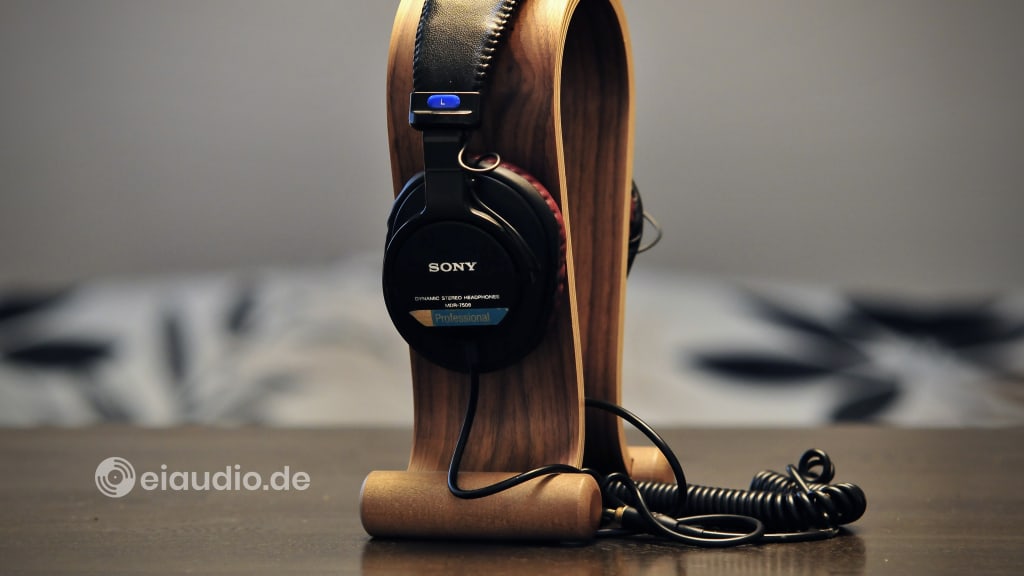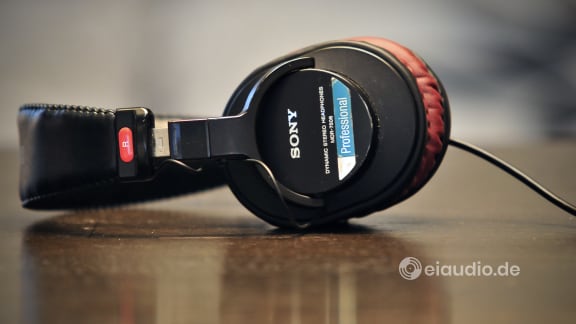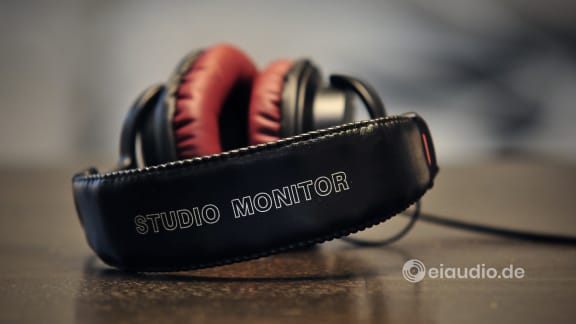Sony MDR-7506 Professional
Published: 28/01/2023
Manufacturing date: 1991
Author: Karsten Hein
Category: Gear & Review
Tag(s): Headphones
I must confess that when my colleague returned from a family trip to the USA and happily reported that he had been gifted with a set of Sony MDR-7506 studio headphones, this did not immediately ring a bell with me. There were two main reasons for my ignorance: It had not been until recently that I had developed an interest in headphones, and my previous impressions of Sony gear had been mediocre at best. Sony used to be quite popular in the low to mid-price consumer market during the 80s and 90s, and this had given the brand the tag ‘OK for the price’, which is close to a death sentence coming from an audiophile, or, as the German pun on the brand name goes: So nie.
When Landon and I took a closer look at the headphones at our Frankfurt office, we found that the soft black imitation leather ear pads were starting to disintegrate from old age. I suggested they might still be available as replacement parts online, and Landon managed to find a reasonably-priced pair of red cushions. I later learned that all the parts used on the MDR-7506 headphones were easily serviceable and available from a host of suppliers. Serviceability has always played a major role in the maintenance of vintage gear, and the Sony studio headphones were certainly not lacking in this respect.
The serviceability and availability of parts would also have been an important aspect for professional users of these headphones. The larger studios of the 90s would own a large number of headphones that was often used by careless studio guests and amateurs alike. The possibility to replace a broken driver or ear pad right at the studio without having to send the headphones in to Sony for servicing would have saved the studio time a money. This also explained why so many MDR-7506 were still around.
Made for professional studio monitoring, the MDR-7506 were of a closed back design. This had two advantages: in the mixing room, the closed and damped shell served well to cancel out ambient noise, and noise radiating from the headphones would less likely find its way into the recording. Wearing the headphones for longer periods of time, I was surprised how well the lightweight ear cups worked in sealing me off from the outside world.
At 230 grams, the MDR-7506 were the lightest headphones I had tested. However this did not mean that they felt light or frail in handling or when wearing them on the head. The single headband was adjustable in size and held the ear pieces firmly in position. At first I was surprised to find that the cushions pressed my ears down flat against my head, but I soon did not notice it anymore. In fact, I was reminded of my dad’s old Panasonic Studio Headphones that had softer inner cushions to minimise the pressure. Wearing glasses with thick temples might be a bit of a challenge, however, I had no problems wearing my glasses with flat temples on the side.
I had mixed feelings about the mechanism that allowed the ear cups to be folded upward into the headband. On the one hand, I could see the advantage of being able to store the headphones in a smaller space. On the other hand, the ear cups continuously folded up in scenarios where this was neither needed nor desired. It was well possible that this feature had been a little tighter when they were new. The other aspect I did not enjoy so much was the non-detachable coiled up cable. Having accidentally rolled over the cable of my AKG headphones with our office chair a few days earlier, I could understand the obvious benefit of having a cable that kept itself short. However, as I was usually sitting quite far from our equipment, I would have prefer to be given a choice. For this reason, AKG offers cables with plugs on the side of the headphones as well as the source.
I began my listening explorations with Helge Lien Trio’s “Album 10”. This begins softly and slowly builds up in loudness and speed with each new song. The music source was our Marantz CD-17 CD player paired with a Cambridge DAC Magic. I could feel the little bit of pressure on the ears and heard the slight ringing from long day at the computer. I heard very little from the surrounding, which was a completely different starting point from my AKG K712 Pro headphones that basically incorporated the room in the listening experience and featured large open-back cups in which the ears could maintain their natural position.
I noticed that the MDR-7506 sounded less airy and more compact in terms of proximity to the listener and also soundstage. They played slightly louder than the AKG and offered a fuller sound with a slightly thickened bass. This more robust bass foundation would serve well when listening to Rock, Pop, or Metal music but most likely come across as emphasis in Jazz or Classical music. I did not notice any bothersome shell resonances as you will find on cheaper and less well-made headphones.
Paired with our Douk Audio T-1 headphone amp with GE tubes, the top end sounded sweet and pleasing. I must say that the JAN 5654W were some formidable tubes for this amp, and the Sony headphones did not take away from their magic. At low volumes, the MDR-7506 sounded a little robust with fast-decaying transients, but at higher listening volumes, the PET diaphragm managed to free itself better, and the music became more spacious and more accurate. Even when playing at higher volumes, bass frequencies did not dominate the music as I had initially feared.
In direct comparison, I found the AKGs to be tonally more accurate and revealing, especially when listening at lower volumes. There was just a bit more insight into the music that served well to gauge the depth and width of each recording. This is not to say that the Sonys were far off, however, which did come as a surprise given the 30+ years of material ageing and scientific advances. I actually found the MDR-7506 to be superior to the Beyerdynamic DT990 Pro and the AKG K702, both of which I have had here for testing and also seen in heavy use at various studios. If I had to come up with an adhoc ranking of headphones, my list for audiophile listening would look like this:
My Current Headphone Ranking
- AKG K712 Pro (the most balanced and tonally accurate)
- Beyerdynamic T1 (nothing to complain about, except for the price)
- Stax New SR-3 (difficult to set up and operate, but sweeeet)
- Sony MDR-7506 (good monitor functions and natural tonality)
- HiFiMAN HE-400i (balanced but a little on the bland side)
- AKG K702 (generally alright but unbalanced, leaning toward bright)
- Sennheiser HD 580 (sweet midrange, lacking precision and bass)
- Beyerdynamic DT 990 (pop-sound with muffled midrange)
Having listened to Helge Lien on CD, I started our Technics SL-1310 with Audio Technica VM 540 ML cartridge to play Fleetwood Mac’s album “Rumours” on vinyl. This made for an enjoyable experience. Returning to our AKG for a quick check, I was surprised how much thinner they sounded. The MDR-7506 here offered a strong and punchy mid-bass with a rhythmical forward drive. As before, they cut a little short in decay and offered slightly less tonal insight. As such, I was reminded of the sound of the 80s and 90s in which sonic finesse was reserved for the ultra-high end of the market. And still I found that the presentation worked very well with the music from the period.
I could see less discerning listeners enjoying the more robust sound of the Sony MDR-7506 more than the AKG, because it was generally more forgiving of the subtle differences in the recordings. Whereas the AKG invited the listener to look past each recording at the spaces that were not sufficiently covered or overly smothered by the music material, the MDR-7506 took the music more at face value and encouraged a more general appreciation of sound. This works quite well and places the Sony above some well-known competitors of its time and beyond.
Specifications
- Type: dynamic studio headphones
- Special features: foldable head band
- Earpiece: on-ear supra-aural, closed-back
- Driver type: 40mm dynamic, neodymium magnets
- Diaphragm: polyethylene terephthalate (PET)
- Nominal impedance: 63 Ohms
- Frequency response: 10 Hz to 20,000 Hz
- Power sensitivity: 106 dB/mW
- Maximum power handling: 1,000 mW
- Plug type: headphone 3.5 mm, TRS
- Connector: gold plated
- Cable design: fixed, coiled
- Cable Length: 1m to 3m (max.)
- Available color(s): black
- Weight: 230 g
- Country of manufacture: Japan
- Year(s): from 1991
- Preceded by: Sony MDR-V6 (1985)




